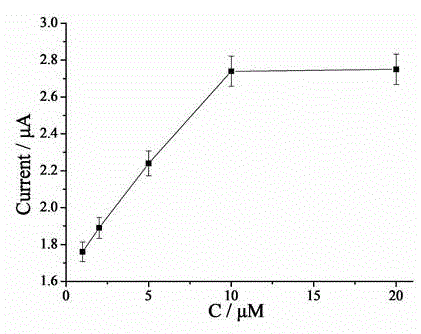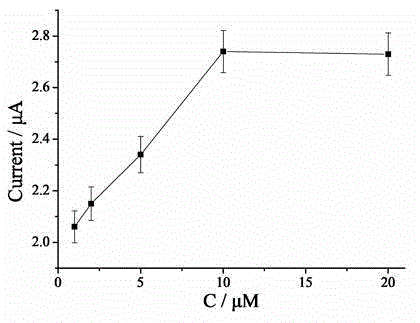Aptamer-based biosensor for detecting penbritin and preparation method of aptamer-based biosensor
A biosensor, ampicillin technology, applied in the field of biosensors, can solve the problems of high cost, low specificity and sensitivity, and achieve the effects of low detection limit, improved sensitivity and accurate quantitative detection
- Summary
- Abstract
- Description
- Claims
- Application Information
AI Technical Summary
Problems solved by technology
Method used
Image
Examples
Embodiment 1
[0055] The main steps of the electrode modification process are as follows:
[0056] a. The gold electrode is firstly polished in 0.3 and 0.05??m alumina slurry until it becomes a mirror surface, and then rinsed repeatedly with PBS and secondary water;
[0057] b. Drop 10 μL of capture probe (10 μM) onto the electrode surface and incubate at room temperature (25°C) for 2 hours. Fix the sulfhydryl chains to the electrode surface through Au-S bonds;
[0058] So far, the modification process of the electrode has come to an end. The following describes the reaction in the homogeneous solution and the main steps in the homogeneous reaction:
[0059] a. Add sterilized water, 10X buffer (buffer), 1 μL hairpin DNA strands (concentrations are 20 μM, 10 μM, 5 μM, 2 μM, 1 μM) and the target substance to a pre-prepared sterilized centrifuge tube middle. Shake for 30s, then put the mixed mixture into a 37°C incubator and incubate for 2h;
[0060] b. Continue to add MB probe (10 μM), po...
Embodiment 2
[0070] A preparation method of the electrochemical biosensor of the present invention:
[0071] The main steps of the electrode modification process are as follows:
[0072] a. The gold electrode is firstly polished in 0.3 and 0.05??m alumina slurry until it becomes a mirror surface, and then rinsed repeatedly with PBS and secondary water;
[0073] b. Drop 10 μL of capture probe (10 μM) onto the electrode surface and incubate at room temperature for 2 hours. Fix the sulfhydryl chains to the electrode surface through Au-S bonds;
[0074] So far, the modification process of the electrode has come to an end. The following describes the reaction in the homogeneous solution and the main steps in the homogeneous reaction:
[0075] a. Add sterilized water, 10X buffer, hairpin-structured DNA strand (10 μM) and the target substance into a pre-prepared sterilized centrifuge tube. Shake for 30s, then put the mixed mixture into a 37°C incubator and incubate for 2h;
[0076] b. Continu...
Embodiment 3
[0082] A preparation method of the electrochemical biosensor of the present invention:
[0083] a. The gold electrode is firstly polished in 0.3 and 0.05??m alumina slurry until it becomes a mirror surface, and then rinsed repeatedly with PBS and secondary water;
[0084] b. Add 10 μL of different concentrations of capture probe (20 μM, 10 μM, 5 μM, 2 μM, 1 μM) onto the electrode surface and incubate at room temperature for 2 hours. Fix the sulfhydryl chains to the electrode surface through Au-S bonds;
[0085] So far, the modification process of the electrode has come to an end. The following describes the reaction in the homogeneous solution and the main steps in the homogeneous reaction:
[0086] a. Add sterilized water, 10X buffer, hairpin-structured DNA strand (10 μM) and the target substance into a pre-prepared sterilized centrifuge tube. Shake for 30s, then put the mixed mixture into a 37°C incubator and incubate for 2h;
[0087] b. Continue to add MB probe (10 μM), ...
PUM
| Property | Measurement | Unit |
|---|---|---|
| thickness | aaaaa | aaaaa |
| thickness | aaaaa | aaaaa |
Abstract
Description
Claims
Application Information
 Login to View More
Login to View More - R&D
- Intellectual Property
- Life Sciences
- Materials
- Tech Scout
- Unparalleled Data Quality
- Higher Quality Content
- 60% Fewer Hallucinations
Browse by: Latest US Patents, China's latest patents, Technical Efficacy Thesaurus, Application Domain, Technology Topic, Popular Technical Reports.
© 2025 PatSnap. All rights reserved.Legal|Privacy policy|Modern Slavery Act Transparency Statement|Sitemap|About US| Contact US: help@patsnap.com



